Abstract
This study evaluates waterproofing methods for underground structures in multi-unit residential buildings. The objective is to select effective methods and establish performance ratings. Experimental assessments are conducted and scores are assigned for ranking. In this regard, waterproofing methods used in the upper slab of the top floor of multi-unit residential building underground structures were investigated, and they were categorized as composite waterproofing, sheet waterproofing, and membrane waterproofing methods. For performance evaluation purposes, experiments were conducted on qualified materials and scores were assigned to each test specimen, with a total score of 100 points. Based on the test results, scores for disqualified materials were deducted and, ultimately, the rankings of waterproofing materials and methods for the upper slab of the top floor of underground structures were determined based on the total aggregated scores. Subsequently, through proximity performance evaluation, the applied waterproofing methods were experimentally verified for defect issues based on the presence or absence of a proximity layer. This led to the ranking and performance grading of a total of 12 materials. The results confirmed the necessity of a proximity layer-dependent waterproofing method and highlighted the superiority of the composite waterproofing method with a proximity layer. Additionally, differences in installation methods and material properties between sheet and membrane waterproofing methods were identified, resulting in variations in performance grading.
1. Introduction
In places where projects such as new city development and urban improvement plans are carried out in Korea, apartment construction plans are generally undertaken to accommodate a large number of people, and apartment buildings often become subjects of lawsuits due to various disputes and complaints [1]. To address this issue, the Ministry of Land, Infrastructure and Transport implemented the “Performance Grade Indication System for Apartment Houses.” This system allows residents to check and select apartment houses based on their performance, and it notifies residents of the performance ratings [2,3]. The system evaluates five aspects: “noise performance”, “structural performance”, “environmental performance”, “living environment performance”, and “fire and fire-fighting performance”, providing performance information in advance [4].
Despite the operation of the above system, the number of disputes and lawsuits related to leakage defects in apartment buildings has been increasing every year. Especially in large underground parking lots, which are becoming more important due to their size and space [5,6,7], the lack of guidelines and post-treatment measures for leakage defects exacerbate the issue of underground space leakage [8,9]. The upper part of the top floor of underground spaces in apartment buildings, in particular, experiences high vibration or movement due to vehicle passage, making it susceptible to rainwater intrusion and leaks caused by cracks [10,11]. Additionally, the top floor of underground parking lots is constantly damaged not only by leaks due to defects in the waterproof layer of the upper slab, but also by issues like soil or gravel weight causing leakage [12,13] (See Figure 1). Therefore, there is an urgent need for laws, institutional leak prevention devices, and guidelines for underground spaces in apartments in Korea [14,15].
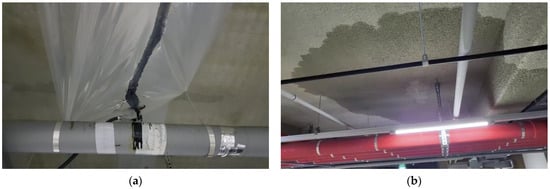
Figure 1.
Defects in the top floor of an apartment building’s basement structure. They should be listed as: (a) upper slab oil leakage; (b) upper slab leakage.
The objective of this study is to select waterproofing methods for the uppermost slab of underground structures in multi-unit residential buildings. This slab is directly exposed to external forces and prone to leakage damage. Experimental evaluations will be conducted to assess the effectiveness of the chosen waterproofing methods and performance rankings will be determined based on assigned scores. Additionally, the performance of each waterproofing method will be classified based on the presence or absence of a drainage layer. The findings will provide fundamental data for establishing waterproofing performance grades, aiming to prevent leakage incidents in multi-unit residential buildings.
2. Study on the Performance Rating Method of Apartment Housing
Korea’s apartment performance rating system was first implemented in January 2006 and revised to enhance standards in July 2007 and January 2009. It was later removed as a housing performance rating requirement in February 2013 and has been operated as a green building certification system since June of the same year. The Ministry of Land, Infrastructure and Transport (Clause No. 2014-705) and the Ministry of Environment (Clause No. 2014-213) currently operate the system in a complex manner according to the “[Table 1] Apartment Certification Review Standards” [16].
The performance rating system for multi-unit residential buildings consists of 56 criteria, categorized into 26 essential items and 30 optional items. When establishing performance ratings, it was observed that 19 criteria are related to determining ratings based on material or method selection. Additionally, 14 criteria involve calculating performance ratios, while 9 criteria relate to upward adjustments of performance through the addition of lower-rated performances. Other criteria include rating based on area, distance, and material/construction quality, as well as performance measurement and scoring. Among these, the top three criteria account for 42 out of the total 56, representing approximately 75% of the criteria. Therefore, adopting these rating methods can contribute to stable utilization of performance ratings in the waterproofing field [17,18,19,20,21,22,23].
In conclusion, the performance ratings incorporated in the preliminary certification of environmentally friendly buildings for multi-unit residential developments are determined based on design drawings, plans, quality certification documents, and the use of high-performance measures [24,25]. Various methods such as the number of applicable materials, ratio per area, distance, scores, and upward adjustments of performance through the addition of materials at lower levels are utilized during the establishment of the rating system [26]. However, it was observed that the evaluation of performance ratings considers factors such as structure and environment but overlooks issues like environmental pollution resulting from the lack of waterproofing application and inconveniences faced by residents. Hence, establishing waterproofing performance ratings is necessary to address leakage prevention.
3. Verification Plan and Test Method for Performance Rating Method
3.1. Checking the Waterproofing Method and Type of Test Evaluation
In Korea, there is a method of constructing a waterproof layer on top of the slab (outer waterproofing method), and a composite waterproofing method and a single waterproofing method (sheets, coating film) are applied depending on the material applied. In addition, an additional root layer is constructed to prevent root intrusion of planting to protect the upper slab on the top floor of the underground structure. Accordingly, materials and methods applied to the upper slab of the top layer of the underground structure were classified into six materials (two composite waterproof materials, three sheet waterproof materials, and one coating waterproof material). The derived results are shown in Table 1 below.

Table 1.
Types of Waterproofing Materials and Methods Used in the Upper Slab of Underground Structures.
As a result of examining the test and evaluation method for waterproof materials and construction methods for grading waterproof performance on the top floor slab of underground structures in apartments selected above, it was confirmed that there is a performance evaluation method for waterproof materials and construction methods operated by the Korean Construction Standards Center (KCSC). In addition, in order to check the performance according to the presence or absence of a root layer, the performance rating was classified in detail by applying the Korean Industrial Standard KS F 4938-18 “Rubber Performance Test Method”. Accordingly, the test verification plan was established as shown in Table 2, utilizing the test evaluation approach of the Korean industrial standard KS F 4938-18 “Rubber Performance Test Method” and the test evaluation methodology outlined in KCS 11 44 00: 2018 Joint District.

Table 2.
Verification Plan for Performance Grading of Upper Slab Materials in Underground Structures.
3.2. Test Method
3.2.1. Performance Evaluation of Joint Residential Complex According to KCS 11 44 00: 2018
Waterproof materials must be applied to the upper slab on the lower floor of the underground structure of apartment houses, and methods such as sheets, coatings, and complex waterproofing are applied. In this situation, it is impossible to evaluate different materials according to specific criteria due to the large variation in physical properties for each material. Therefore, physical properties were verified to grade waterproof performance by applying the performance evaluation method of KCS 11 44 00: 2018 Joint District and tests were conducted on materials G to L without a root layer. The test methods conducted are shown in Table 3 below.

Table 3.
Test Methods for Performance Verification of Upper Slab in Underground Structures.
3.2.2. Korea Industrial Standard KS F 4938-“18” “Standard Test Method for Root Penetration Resistance”
The root-proof performance test method is evaluated by applying each waterproof method and root-proof method inside a perforated root test body that can observe 800 × 800 × 220 mm of planting, planting it, and growing the plant for 24 months so that the root of the plant can grow sufficiently(Refer to Figure 2).

Figure 2.
KS F 4938- “18” “Standard test method for root penetration resistance” Test equipment.
4. Results of Waterproof Performance Rating for Underground Structures in Apartment Buildings
4.1. KCS 11 44 00: 2018 “Joint District” Performance Evaluation Test Results
4.1.1. KCS 11 44 00: 2018 “Joint District” Evaluation Index Checked
KCS 11 44 00: 2018 “Joint District” was allocated to diversify the scores by deducting points from the number of failed tests so that quantitative performance results could be derived from the original evaluation index and the scores were set as points according to the evaluation results from 1 to 8 in Table 4 below.

Table 4.
KCS 11 44 00: 2018 “Joint District” Evaluation Criteria and Scoring.
4.1.2. Chemical Settlement Stability
The test results for chemical immersion stability are shown in Figure 3 and Figure 4 below. As a result of the chemical immersion stability test, material G was identified as having 17 points due to the excitation between materials in one test piece, and material H was identified as having 14 points due to the excitation and swelling of joints in two tests. In addition, material I was identified as having eight points due to joint excitation and end excitation in two test pieces, and material J was identified as having eight points due to joint excitation in four test pieces. Material K was identified as having 11 points due to bond excitation in three test pieces and, finally, swelling occurred in two test pieces of material L, giving it 14 points.
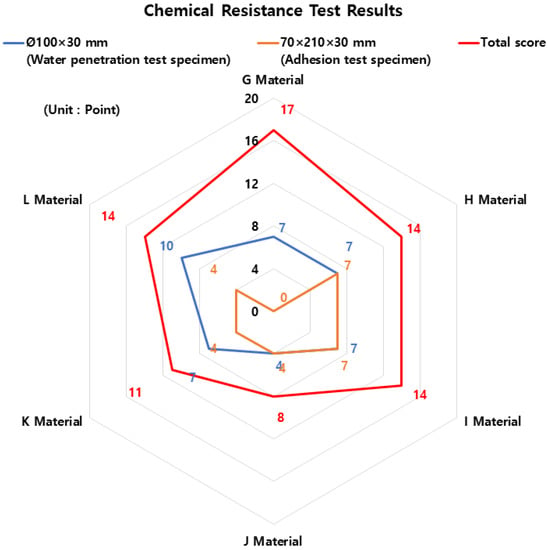
Figure 3.
KCS 11 44 00: 2018 “Joint District” Chemical Resistance Test Results.

Figure 4.
KCS 11 44 00: 2018 “Joint District” Chemical Resistance Test Results. They should be listed as: (a) Chemical Resistance Test Specimens; (b) Chemical Resistance Test Status.
4.1.3. Structural Response and Adaptability
Figure 5 and Figure 6 show the test results for Structural Response and Adaptability. As a result of the Structural Response and Adaptability test, material G leaked from one wet surface, and material H leaked from one wet surface to 17 points for both the lowest floor slab and the outer wall. In addition, leakage occurred in two wet surfaces and one dry surface of material I, and both the lowest floor slab and the outer wall were identified as having 11 points, and material J, material K, and material L were identified as having 2 points.
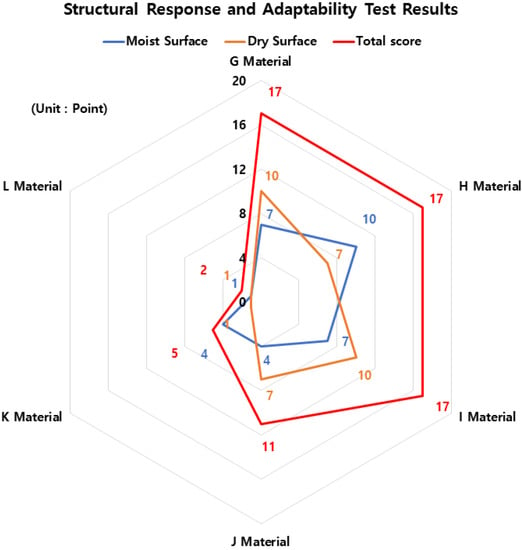
Figure 5.
KCS 11 44 00: 2018 “Joint District” Chemical Resistance Test Results.

Figure 6.
KCS 11 44 00: 2018 “Joint District” Structural Response and Adaptability Test Results. They should be listed as: (a) non-leakage test specimen (surface dry); (b) leakage test specimen (surface moist state).
4.1.4. Moisture Adhesion Stability
Figure 7 shows the test results for Moisture Adhesion Stability. As a result of the Moisture Adhesion Stability test, materials G, H, and L were identified as having 10 points because there was no abnormality in the test piece under all conditions, and material I was identified as having 8 points due to floating in freezing melting and cold and hot repeatedly. In addition, material J was identified as having 7 points due to the occurrence of excitation in wet, frozen melting, and cold and hot repetition, and material K was identified as having 5 points due to excitation in all tests except for the dry surface.
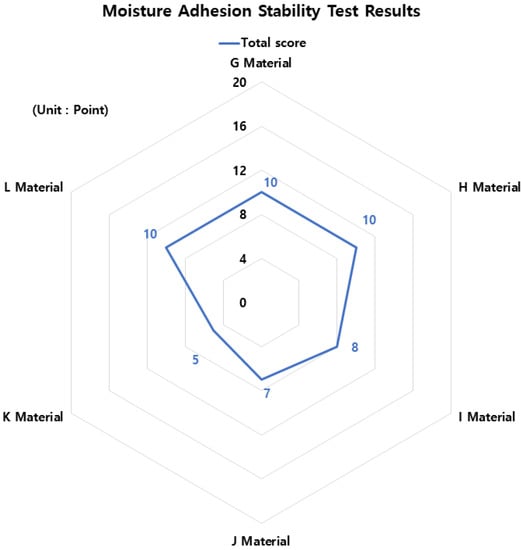
Figure 7.
KCS 11 44 00: 2018 “Joint District” Moisture Adhesion Stability Test Results.
4.1.5. Water Tightness
The test results for water tightness are shown in Figure 8 and Figure 9 below. As a result of the water tightness test, all materials were confirmed to have 10 points because no pitcher was generated in the test piece under all conditions.
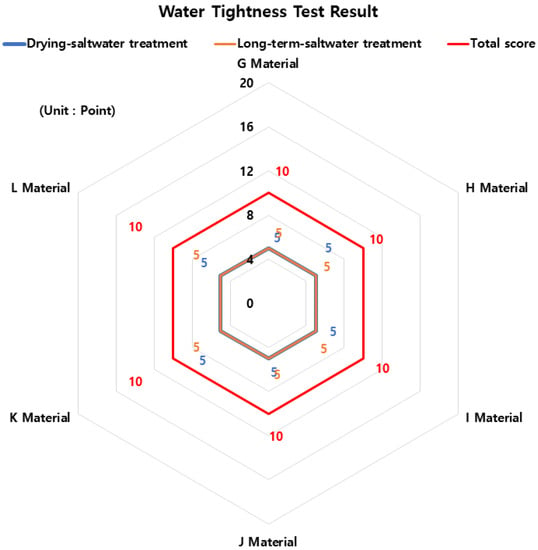
Figure 8.
KCS 11 44 00: 2018 “Joint District” Water Tightness Test Result.
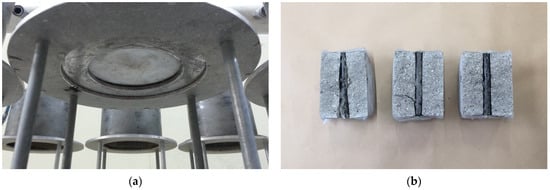
Figure 9.
KCS 11 44 00: 2018 “Joint District” Water Tightness Test Results. They should be listed as: (a) water tightness test; (b) water tightness test result.
4.1.6. Temperature Dependence
The test results for temperature dependence are shown in Figure 10. As a result of the temperature dependence test, all materials were confirmed to have 10 points because no permeation occurred in the test piece under all conditions.
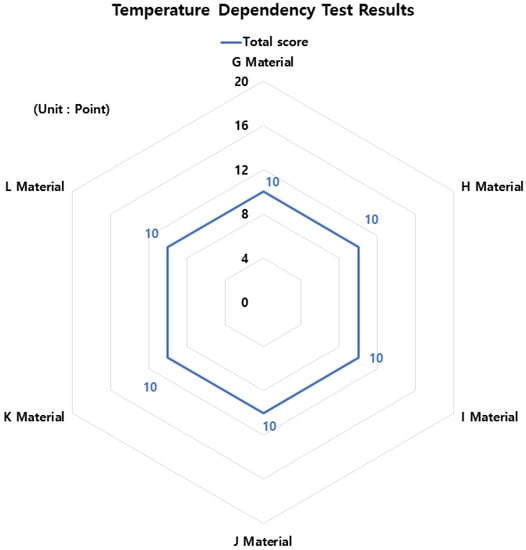
Figure 10.
KCS 11 44 00: 2018 “Joint District” Temperature Dependency Test Results.
4.1.7. Crack Resistance
The test results for crack resistance are shown in Figure 11 and Figure 12. As a result of the crack resistance test, all materials were confirmed to have 10 points because cracks and fractures did not occur in the test piece under all conditions.
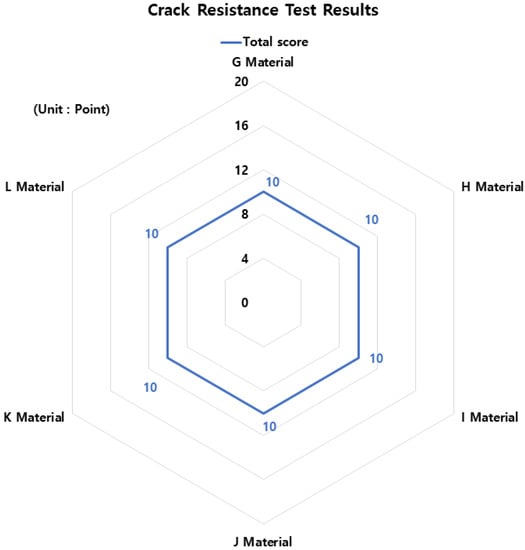
Figure 11.
KCS 11 44 00: 2018 “Joint District” Crack Resistance Test Results.
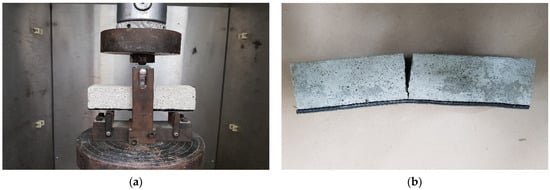
Figure 12.
KCS 11 44 00: 2018 “Joint District” Crack Resistance Test Results. They should be listed as: (a) Crack Resistance test; (b) Crack Resistance test result.
4.1.8. Durability
The test results for durability are shown in Table 5 and Figure 13. As a result of the durability test, all materials were found to have 10 points because they satisfied all of the quality standard items.

Table 5.
KCS 11 44 00: 2018 “Joint District” Durability Test Results.

Figure 13.
KCS 11 44 00: 2018 “Joint District” Durability Test Results.
4.1.9. Stability of Low-Temperature Adhesion
The test results for the stability of low-temperature adhesion are shown in Figure 14 and Figure 15. As a result of the low-temperature adhesion stability test, all materials were confirmed to have 10 points because no pitcher was generated in the test piece under all conditions.

Figure 14.
KCS 11 44 00: 2018 “Joint District” Low-Temperature Adhesion Stability Test Results.

Figure 15.
KCS 11 44 00: 2018 “Joint District” Low-Temperature Adhesion Stability Test Results. They should be listed as: (a) low-temperature bonding installation; (b) Low-Temperature Adhesion Stability Test Results.
4.1.10. KCS 11 44 00: 2018 “Joint District” Performance Evaluation Comprehensive
The comprehensive results of the KCS 11 44 00: 2018 “Joint District” performance evaluation are shown in Table 6, and Figure 16 and Figure 17 below. According to the overall results of the performance evaluation, material G (composite waterproofing method (adhesive flexible seal material + improved asphalt waterproofing sheet)) was given 94 points out of 100 points and material H (composite waterproofing method (urethane coating waterproofing + improved asphalt sheet waterproofing)) was given 91 points. Material I (self-adhesive waterproof sheet (rubber asphalt or butyl rubber)) was given 89 points, and material J (improved asphalt water-proof sheet (rubber asphalt)) and material L (coating waterproof material (rubber asphalt or urethane rubber)) were given 76 points. Lastly, material E (synthetic polymer waterproof sheet (vinyl chloride resin)) was confirmed to have a score of 71.

Table 6.
KCS 11 44 00: 2018 “Joint District” Overall Performance Evaluation Results.

Figure 16.
KCS 11 44 00: 2018 “Joint District” Overall Performance Evaluation Results.

Figure 17.
KCS 11 44 00: 2018 “Joint District” Overall Performance Evaluation Results (Total Score).
4.2. Korea Industrial Standard KS F 4938-18 Test Result of “Root Penetration Resistance Test Method”
4.2.1. Test Specimen Composition
The barometric performance test was conducted with the composition and test specimen using the following method as shown in Table 7.

Table 7.
Diagram and Test Specimen for Root Penetration Resistance Performance by Waterproofing Methods.
4.2.2. Results of Root Penetration Resistance Performance Test
Table 8 shows the results of the root penetration resistance performance test. As a result of two years of observation, materials A to F installed with the root layer did not find any root penetration or change in the waterproof layer, and materials G to L without the root layer protruded from the general part or penetrated the joint and general part.

Table 8.
Root Penetration Resistance Performance Test results.
4.3. Consideration
Based on the above performance evaluation results, the score deviations of material G, material H, and material I were not large and similar, and the score deviation of material J, material K, and material L were found to be similar. In addition, it was confirmed that defects in the waterproof layer occurred depending on the presence or absence of the waterproof layer regardless of the material group. Accordingly, the rating of the upper slab on the top floor of the apartment building needs to be calculated by classifying waterproof methods without a barrier layer into grades 3 and 4, and waterproof methods with a barrier layer into grades 1 and 2. The results of the grading setting accordingly are shown in Table 9.

Table 9.
Overall Performance Rating Determination Results.
5. Conclusions
The conclusions of this study are as follows:
- According to the performance evaluation of the apartment building, the waterproof method applied to the upper slab on the top floor of the underground structure of the apartment building was excellent, and some sheet waterproof methods were found to have similar performance to or lower performance than the coating waterproof method. Self-adhesive waterproof sheets with excellent adhesion performance are judged to be highly responsive to the underground environment, and synthetic polymer waterproof sheets constructed using adhesives have lower scores than coating waterproofing methods due to problems such as adhesion due to the underground wet environment.
- The performance score of the same asphalt-based self-adhesive waterproof sheet and the improved asphalt waterproof sheet differed in the performance score in the joint performance evaluation, due to the deterioration of the physical properties and construction quality of the sheet.
- Accordingly, it is necessary to grade the waterproof performance by classifying the improved asphalt waterproof sheet, synthetic polymer waterproof sheet, and coating waterproof material into the same performance grade.
- In the case of the composite waterproof method without a barrier layer, it received excellent performance scores in the performance evaluation of the apartment building but, if a separate barrier layer is not constructed, it still acts as a waterproof defect. Therefore, in order to prevent defects due to this cause in advance, it is reasonable to mark them at a lower performance grade than the performance grade with a barrier layer.
This study focused on developing a waterproof performance rating method specifically for the upper slab of the top floor in the underground structure of apartments, aligning with the performance rating approach used for apartment houses in Korea. The findings are anticipated to serve as fundamental data for a universal waterproof performance rating applicable to various concrete building structures, taking into account evaluation methods and standards outlined by International Standards (ISO).
Author Contributions
Conceptualization, Methodology, Laboratory work, Data curation, Writing—original draft preparation, K.-w.A.; Conceptualization, Methodology, Writing—reviewing and editing, B.-i.K. All authors have read and agreed to the published version of the manuscript.
Funding
This research received no external funding.
Data Availability Statement
The data presented in this study are available on request from the corresponding author.
Acknowledgments
This study was financially supported by the Seoul National University of Science & Technology.
Conflicts of Interest
The authors declare no conflict of interest for the publication of the review paper.
References
- An, K.W. Applicability of Grading System for Residential Building Waterproofing Performance. Doctoral Dissertation, Seoul National University of Science and Technology, Seoul, Republic of Korea, 2021; pp. 45–147. [Google Scholar]
- An, K.W.; Cho, I.K.; Oh, S.K. Study on the Improvement of Waterproofing Performance Rating for the Introduction of Residential Apartment Complex Performance Grade Index. J. Archit. Inst. Korea Struct. Constr. 2018, 34, 41–49. [Google Scholar]
- An, K.W.; Kang, H.J.; Cho, I.K.; Oh, S.K. Requirement of Performance Evaluation Criteria of Waterproofing Field for Residential Buildings—Professional Survey Based Data. Archit. Inst. Korea 2018, 38, 780–781. [Google Scholar]
- An, K.W.; Kim, S.Y.; Oh, S.K. Development and Study on the Future Employment of Waterproofing Design Guideline for Leakage Prevention of Residential Underground Structure. Archit. Inst. Korea 2017, 37, 1073–1074. [Google Scholar]
- An, K.W.; Lee, Y.S.; Lee, J.H.; Song, J.Y.; Oh, S.K. Humidity Change Rate Analysis for Various Waterproofing Method in Underground Structures During Winter Season. J. Korea Inst. Struct. Miant. Insp. 2016, 20, 118–125. [Google Scholar]
- Jang, S.M.; Choi, S.M.; Lee, J.H.; An, K.W.; Oh, S.K. A Study on the Characteristics of Temperature-Humidity by the Location of Waterproofing Layer with the Concrete Wall as the Center in the Basement; Korea Concrete Institute: Seoul, Republic of Korea, 2013; pp. 31–32. [Google Scholar]
- Choi, S.M.; Jang, S.M.; An, K.W.; Lee, J.H.; Song, J.Y.; Oh, S.K. A Study on the Characteristics of Temperature-Humidity by Applying the Waterproofing Layer on the Out of Concrete Wall in the Underground Parking Lot. Archit. Inst. Korea 2013, 33, 589–590. [Google Scholar]
- An, K.W.; Kim, D.B.; Choi, S.Y.; He, X.Y.; Oh, S.K. Investigation on Products and Regulation of Flexible Adhesive Rubber Asphalt Type Sealant for the Development of Korea-China Joint Standard. J. Korean Recycl. Constr. Resour. Inst. 2019, 7, 323–332. [Google Scholar]
- Lee, S.Y.; Cho, D.Y.; Park, C.Y.; Lee, S.H. Comparative Analysis of Evaluation Score Calculation Methods for Grading Certification of Overseas Green Building Certification Systems and Domestic Green Building Certification System. J. Archit. Inst. Korea Plan. Des. 2013, 29, 283–290. [Google Scholar]
- Kim, M.S.; Hwang, J.W.; Chun, J.G.; Ha, D.W.; Park, K.S.; Son, W.T. A Study on the Improvement of Assessment Criteria for Housing Performance Indicator System and Green Building Certification Criteria. J. Archit. Inst. Korea Plan. Des. 2009, 29, 283–290. [Google Scholar]
- Becker, R. A unified methodology for establishing minimum performance criteria and performance grading tools for buildings. Build. Environ. 1993, 28, 243. [Google Scholar] [CrossRef]
- Bono, A.B.; Bono, S.T. Integrating Below-Grade Waterproofing into Structural Details for Successful Building Performance: A Case Study. Concr. Int. 2012, 34, 41–45. [Google Scholar]
- Shi, J.; Wu, L.; Liu, J.; Liu, C.; Liu, B.; Song, J. Study on Combustion Performance of A Grade of Building Thermal Insulation Materials. Guangdong Chem. Ind. 2020, 47, 79–80. [Google Scholar]
- Korea Land & Housing Corporation. Establishment of Measures to Improve Quality of House Waterproofing; Korea Land & Housing Corporation: Jinju, Republic of Korea, 2017. [Google Scholar]
- Methods for Zero Defects in Quality Management; Public Housing Project Office: Gyeongnam, Republic of Korea, 2017; p. 3.
- Korea Institute of Construction Technology. Research on the Establishment of Standards for Installation and Maintenance of Ventilation Facilities; Ministry of Land, Infrastructure and Transport: Sejong, Republic of Korea, 2016.
- Korean Industrial Standard KS F 4938-18; Test Methods for Ground Penetrability Performance; Korean Agency for Technology and Standard. KATS: Seoul, Republic of Korea, 2018.
- KCS 11 44 00-18; Standard Specifications for Common Structures. The National Construction Standards Center: Goyang-si, Republic of Korea, 2019.
- Korean Industrial Standard KS F 4935-18; Injectable Sealing Material Lor Leak Repair of Adhesive Flexible Rubber Asphalt-Based; Korean Agency for Technology and Standard. KATS: Seoul, Republic of Korea, 2018.
- Korean Industrial Standard KS F 4934-18; Self-Adhesive Rubberized Asphalt Waterproof Sheet; Korean Agency for Technology and Standard. KATS: Seoul, Republic of Korea, 2018.
- Korean Industrial Standard KS F 3211-15; Construction Waterproofing Membrane; Korean Agency for Technology and Standard. KATS: Seoul, Republic of Korea, 2021.
- Korean Industrial Standard KS F 4917-16; Modified Asphalt Waterproof Sheet; Korean Agency for Technology and Standard. KATS: Seoul, Republic of Korea, 2022.
- Korean Industrial Standard KS F 4911-19; Synthetic Polymer Waterproofing Sheet; Korean Agency for Technology and Standard. KATS: Seoul, Republic of Korea, 2019.
- Public Works Department of Malaysia. Guidelines on the Prevention of Mould Growth in Buildings; Public Works Department of Malaysia: Kuala Lumpur, Malaysia, 2009.
- Yang, J.; Peng, G.-F.; Shui, G.; Zhang, G. Mechanical Properties and Anti-Spalling Behavior of Ultra High-Performance Concrete with Recycled and Industrial Steel Fibers. Materials 2019, 12, 783. [Google Scholar] [CrossRef] [PubMed]
- Jansson, R. Fire Spalling of Concrete: Theoretical and Experiment Studies. Ph.D. Thesis, KTH Royal Institute of Technology, Stockholm, Sweden, 2013. [Google Scholar]
Disclaimer/Publisher’s Note: The statements, opinions and data contained in all publications are solely those of the individual author(s) and contributor(s) and not of MDPI and/or the editor(s). MDPI and/or the editor(s) disclaim responsibility for any injury to people or property resulting from any ideas, methods, instructions or products referred to in the content. |
© 2023 by the authors. Licensee MDPI, Basel, Switzerland. This article is an open access article distributed under the terms and conditions of the Creative Commons Attribution (CC BY) license (https://creativecommons.org/licenses/by/4.0/).



































